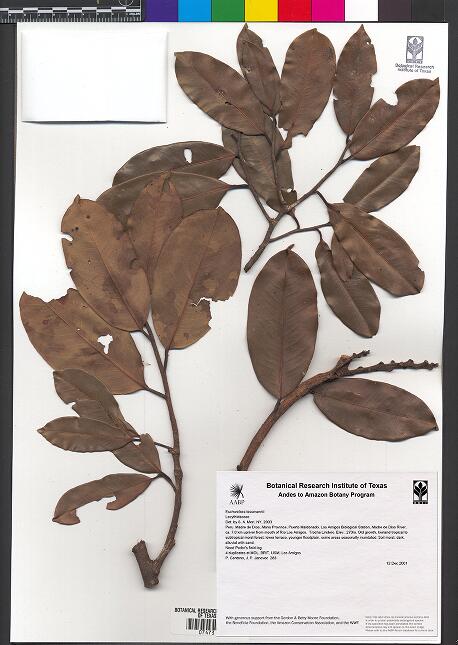Lecythidaceae
Eschweilera tessmannii R. Knuth

Kingdom: Plantae Rank: Species Parent: Eschweilera Status: Valid
Common Names:
- Machimango, machimango colorado (Peru). - English, Peru
Morphological Description
Diagnosis: Dark red inner bark; ferruginous pedicels and hypanthia; relatively small flowers; and cup-shaped fruits.
Vegetative Morphology
Habit: Trees, canopy, to 30 m tall. Trunks, not buttressed. Bark smooth with hoop marks, dimples or pock marks often present lower on trunk, the inner bark 3-6 mm thick, red.
Leaves: Leaves with petioles 11-12 mm long; blades 7-12 x 3.5-4.5 cm, elliptic, glabrous; base acute to obtuse; margins entire; apex acute to acuminate, domatia absent; midrib salient at base adaxially, the secondary veins in 7-9 pairs.
Stipules: Stipules absent, at least in adults.
Exudate: Exudate absent.
Reproductive Morphology
Inflorescence: Inflorescences terminal or in axils of uppermost leaves, simple racemes or once-branched paniculate arrangements of racemes, the rachises ferruginous pubescent; pedicels 5-7 mm long, ferruginous.
Flowers: Flowers 2-3 cm diam.; calyx lobes 4-6.5 x 2.5-5 mm, widely to very widely ovate, ferruginous pubescent; petals white, sometimes tinged with pink; androecial hood yellow; style geniculate.
Fruit: Fruits dehiscent, 2-3.5 (excluding opercum) x 2-4.5 cm, cup-shaped, the operculum dome-shaped, often with small, spine-like umbo.
Seeds: Seeds with lateral aril.
Other
Uses: There are no reported uses of this species.
Distribution: Central and western Amazonian Brazil and Amazonian Peru.
Ecology: Mostly found in non-flooded forests. A 100-hectare plot in central Amazonian Brazil has an average of 2.5 individuals per hectare.
Chromosome Number: Unknown.
Notes: Herbarium specimens have been collected in June and from August through October. There are no observations on the pollination biology of this species. Other species of Eschweilera are pollinated by bees which probably also pollinate E tessmannii. The seeds have a fleshy lateral aril that may be sought after by bats and the seeds could also be scattered hoarded by rodents; there are, however, no observations to support either of these suggestions.
Typification
Type Citation: Pflanzenr. IV. 219a: 115. 1939.
Basionym: Not applicable.
Basionym Citation: Not applicable.
Type Locality: Peru. Loreto: Mouth of Río Santiago.
Type Collection: Tessmann 4691
Types Deposited at: Holotype: Lectotype, NY; Isotypes: Isolectotype, INPA
Other Published Figures: Contribución a la flora de la Amazonia Peruana. Los arboles del arboretum Jenaro Herrera, vol.2. Fig. 133.